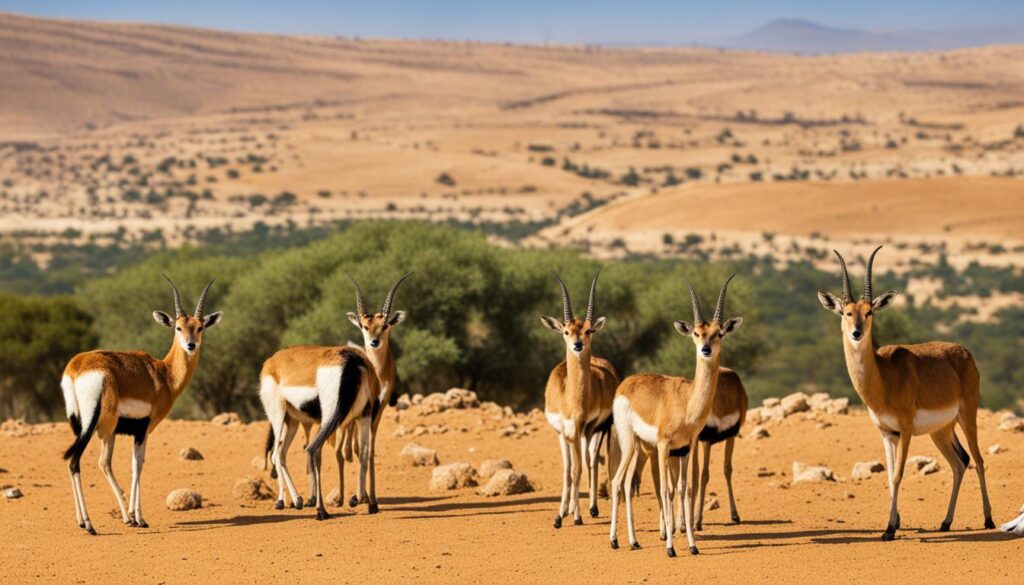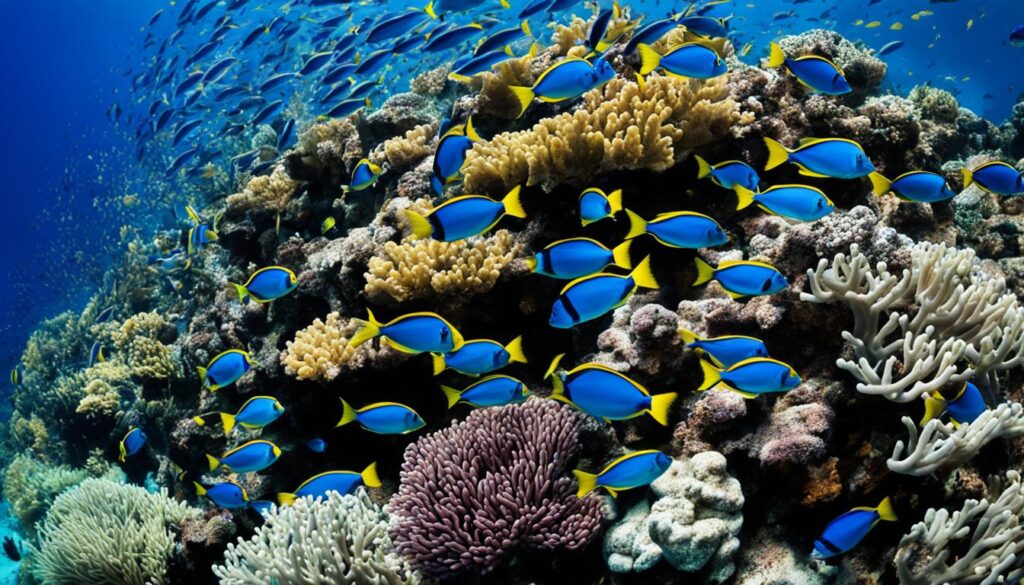Israel is not only known for its historical sites and cultural heritage but also for its rich wildlife and diverse ecosystems. Situated between different climate zones, the country boasts a wide range of animal species, making it a haven for wildlife enthusiasts and nature lovers. From mammals to reptiles, fish to birds, Israel’s animal kingdom is a fascinating blend of native and migratory species.
Exploring the wildlife in Israel offers a glimpse into the intricate balance of nature and the challenges faced by these remarkable creatures. As human activities and habitat loss continue to threaten their existence, conservation efforts are crucial for preserving and protecting the animal species in Israel.

Key Takeaways:
- Israel’s diverse wildlife is a result of its unique geographical location.
- The country is home to various animal species, including mammals, reptiles, fish, and birds.
- Habitat loss and human activities pose significant threats to the animal population in Israel.
- Conservation efforts are essential for preserving the native animal species.
- Israel is an important stopover for migratory birds during their bi-annual journeys.
Mammals in Israel
Israel is home to a wide range of mammal species, each playing a vital role in the country’s ecosystem. However, many of these furry inhabitants are under threat due to illegal hunting, habitat destruction, and urbanization. Wildlife conservation efforts in Israel are crucial in ensuring the survival of these native animal species for future generations.
One of the endangered mammals in Israel is the Arabian leopard. Known for its grace and beauty, the Arabian leopard population has drastically declined due to hunting and the shrinking of its natural habitat. Efforts are being made to protect and conserve this majestic species.
The Nubian ibex is another iconic mammal in Israel that is facing significant conservation challenges. With its impressive curved horns and agile nature, the Nubian ibex is beloved by locals and tourists alike. Conservation organizations in Israel are working to protect this species from poaching and habitat loss.
The Syrian spadefoot toad is a unique amphibian found in Israel. Its survival is threatened by the degradation of wetland habitats. Conservation efforts aim to restore and protect the habitats of this fascinating toad, ensuring its continued existence in Israeli ecosystems.
“Protecting the native animal species of Israel is not only important for their survival, but also for maintaining the biodiversity and ecological balance of the country,” says Dr. Rachel Cohen, a wildlife conservation expert.
Conservation initiatives in Israel focus on habitat restoration, enforcing strict anti-poaching measures, and raising awareness about the importance of protecting endangered animals. These efforts are crucial in preserving the rich wildlife heritage of Israel and fostering a harmonious coexistence between humans and native animal species.
Endangered Mammals in Israel
| Species | Status |
|---|---|
| Arabian Leopard | Endangered |
| Nubian Ibex | Endangered |
| Syrian Spadefoot Toad | Endangered |
Reptiles and Amphibians in Israel
Israel boasts a rich diversity of reptiles and amphibians, with approximately 100 reptile species and several amphibian species calling this vibrant country home. These fascinating creatures have adapted to survive in varying habitats, showcasing the unique ecosystems found in Israel.
Notable Reptiles of Israel
Among the reptiles of Israel, several species stand out for their remarkable adaptations and ecological significance. The Nile crocodile, Levant viper, and Syrian spadefoot toad are just a few examples of the reptilian wonders found here.
“The Levant viper, known for its beautiful markings and potent venom, plays a crucial role in controlling rodent populations, maintaining balance in the ecosystem,” says Dr. Sarah Cohen, a herpetologist specialized in Israeli reptiles.
Challenges for Israeli Amphibians
Although Israel is home to a variety of amphibians, including the elusive Hula painted frog and the striking fire salamander, these unique creatures face numerous challenges. Habitat loss and pollution have led to a decline in their populations, threatening their existence in the wild.
Protecting Reptile and Amphibian Habitats
Conservation efforts are integral to safeguarding the habitats of these remarkable reptiles and amphibians in Israel. Dedicated organizations work tirelessly to raise awareness, implement protective measures, and restore degraded ecosystems to ensure the continued survival of these incredible creatures.
By preserving and respecting the natural habitats of reptiles and amphibians, we can contribute to the conservation of Israel’s rich biodiversity and secure a future where these fascinating creatures thrive.
| Reptiles of Israel | Amphibians of Israel |
|---|---|
| Nile crocodile | Hula painted frog |
| Levant viper | Fire salamander |
| Syrian spadefoot toad | |
| … |
Fish in Israel
Israel is blessed with a remarkable aquatic biodiversity, harboring approximately 1,728 species of fish in its waters. This rich diversity includes both freshwater and marine species, creating a thriving ecosystem for fish in the region.
One of the fascinating aspects of fish species in Israel is the survival and adaptation of certain breeds in extreme environments. For instance, the Dead Sea killifish, a unique species found only in Israel’s Dead Sea, has evolved to withstand the extreme salinity levels of this iconic body of water.
Another notable fish species found in Israel is the acanthobrama hulensis. Thought to be extinct, this resilient fish has made a remarkable comeback and can now be found in the Yarkon River. The rediscovery of this species highlights the importance of preserving and protecting the delicate balance of aquatic habitats in Israel.
The Red Sea’s Blue and Dead Sea Killifish

The Red Sea’s blue fish is a prime example of the diverse marine species found in Israel. With its vibrant colors and unique adaptations, this fish adds to the visual spectacle of Israel’s underwater landscapes. Similarly, the Dead Sea killifish, with its ability to thrive in the extremely salty waters of the Dead Sea, represents the incredible resilience of fish species in the face of challenging environmental conditions.
Conservation efforts in Israel are crucial for preserving the aquatic biodiversity that plays a vital role in the overall ecosystem. By protecting these diverse fish species and their habitats, we can maintain the delicate balance that sustains life in Israel’s waters.
Preserving Aquatic Biodiversity
Conservation initiatives in Israel strive to protect and preserve the aquatic biodiversity present in its waters. By raising awareness, implementing sustainable practices, and enacting strict regulations, efforts are being made to ensure the continued existence of fish species in Israel.
The conservation of aquatic habitats, such as rivers, lakes, and the Mediterranean Sea, is essential for safeguarding the diverse fish populations that call these areas home. These efforts not only contribute to the preservation of fish species but also promote the overall health and sustainability of Israel’s aquatic ecosystems.
By valuing and protecting the aquatic biodiversity of Israel, we can ensure that future generations can enjoy the wonders of its rich fish species and appreciate the vital role they play in maintaining the ecological balance.
Birds in Israel
Israel is a significant stopover point for millions of birds during their bi-annual migration between Europe and Africa. The country’s diverse ecosystems provide an ideal resting and feeding ground for these winged travelers. With over 500 bird species, Israel offers a haven for birdwatching enthusiasts and nature lovers.
Some of the fascinating Israeli bird species include the iconic hoopoe, known for its distinctive crest and vibrant plumage. Another remarkable bird found in Israel is the pink-backed pelican, a rare sight with its striking pink plumage and impressive wingspan. The African sacred ibis is also a commonly sighted bird, known for its elegant appearance and graceful flights.
Birdwatching is a popular activity in Israel, attracting both locals and international visitors. The country boasts several dedicated birdwatching centers and stations, providing enthusiasts with excellent opportunities to observe these beautiful creatures in their natural habitats. From the lush Hula Valley to the stunning Eilat Mountains, there are countless locations across Israel for birdwatchers to explore and discover diverse avian species.

| Bird Species | Description |
|---|---|
| Hoopoe | The hoopoe is a stunning bird with a distinctive crown of feathers and a mesmerizing pattern of colors on its body. |
| Pink-backed Pelican | This rare pelican species is known for its pink plumage and impressive size, making it a sight to behold. |
| African Sacred Ibis | The African sacred ibis is an elegant bird with a long curved beak and beautiful white plumage. |
Whether you’re an avid birder or simply appreciate the beauty of nature, birdwatching in Israel is a must-do experience. Immerse yourself in the vibrant world of Israeli bird species and witness the awe-inspiring sight of millions of migrating birds in flight.
Lesser Known Animals of Israel
In addition to the well-known animal species, Israel is also home to several lesser-known animals. These unique wildlife inhabitants add to the country’s rich biodiversity and contribute to its ecological balance.
One of the lesser-known animals found in Israel is the lesser Egyptian jerboa. This small mammal belongs to the rodent family and is known for its long hind legs, which enable it to hop long distances. The lesser Egyptian jerboa primarily inhabits sandy areas and is well-adapted to the desert environment.
The sand cat is another fascinating creature found in Israel. This small, nocturnal cat has adapted to the arid desert regions of the country. The sand cat’s fur acts as an effective camouflage, allowing it to blend seamlessly into its surroundings.
The marbled polecat is a lesser-known carnivorous mammal found in Israel. It has a distinctive appearance, with dark brown fur and white patches on its face and body. Despite its name, the marbled polecat is not closely related to the domesticated polecat, and it is primarily found in rocky areas.
Israel is also home to the blind scorpion, a unique arachnid species. This scorpion has adapted to living in underground burrows and relies heavily on its sense of touch and vibrations to navigate its dark environment.
These lesser-known animals of Israel demonstrate the country’s incredible diversity of wildlife. They have evolved unique adaptations to survive in challenging environments and are essential for maintaining the delicate ecological balance.
Conclusion
The remarkable biodiversity of animal species in Israel highlights the urgent need for wildlife conservation efforts in the country. Unfortunately, animals in Israel face significant threats such as habitat loss, illegal hunting, and pollution. These challenges jeopardize the survival of many native species.
However, conservation organizations in Israel are working tirelessly to protect and preserve the habitats of these unique animals. By implementing sustainable practices and raising awareness about the importance of wildlife conservation, we can make a positive impact. It is crucial to ensure that future generations can still enjoy the diverse wildlife that Israel has to offer.
Preserving Israel’s biodiversity is not only crucial for the survival of individual species but also for the overall health and balance of the ecosystem. Every animal plays a vital role in the interconnected web of life, contributing to the stability and resilience of the ecosystem as a whole.
Let us join forces to support wildlife conservation initiatives in Israel. By actively participating in efforts to protect our natural heritage, we can make a lasting difference and secure a brighter future for the incredible array of animal species that call Israel home.
FAQ
What kind of wildlife can be found in Israel?
Israel is home to a variety of mammal, reptile, amphibian, fish, and bird species. The country’s diverse habitats support a wide range of animal species.
Are there any endangered animals in Israel?
Yes, unfortunately, many animals in Israel are endangered or at risk of extinction. Illegal hunting, habitat destruction, and urbanization have contributed to their decline. Wildlife conservation efforts aim to protect and preserve these native animal species.
How many reptile and amphibian species are found in Israel?
Israel is home to around 100 species of reptiles and several amphibian species. These include unique reptiles such as the Nile crocodile and Levant viper, as well as amphibians like the Hula painted frog and fire salamander.
What is the fish biodiversity like in Israel?
Israel has a rich diversity of fish species, with approximately 1,728 species found in its waters. Both freshwater and marine species can be found, including unique fish like the Red Sea’s blue and Dead Sea killifish.
How many bird species can be found in Israel?
Over 500 bird species can be found in Israel, with the country serving as a significant stopover point for millions of birds during their bi-annual migration between Europe and Africa. Popular bird species include the hoopoe, pink-backed pelican, and African sacred ibis.
Are there any lesser-known animals in Israel?
Yes, Israel is also home to several lesser-known animals such as the lesser Egyptian jerboa, sand cat, marbled polecat, and blind scorpion. These animals have unique adaptations to survive in Israel’s diverse landscapes.
What threats do animals in Israel face?
Habitat loss, illegal hunting, and pollution are significant threats to animals in Israel. Conservation organizations are working to protect and preserve their habitats through sustainable practices and raising awareness.
Why is wildlife conservation important in Israel?
Israel’s diverse range of animal species highlights the importance of wildlife conservation efforts. By protecting and preserving their habitats, we can ensure the survival of the unique wildlife in Israel for future generations to enjoy.
